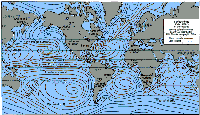England and Iceland have much warmer and more moderate climates than would be expected just by looking at their location. Their latitude is similar to that of northern Canada, Labrador and Alaska, which experience a very different climate. Why?
The key to this puzzle lies in understanding the power of the wind over the vast, flat areas of ocean.
Currents
and the Effect of the Earth Spinning
Over 70 % of the Earth's surface is covered with water. Wind helps this
water to move and circulate. Wind powered surface currents move the majority
of water from one place in the ocean to another. Surface currents which
originate near the equator are warm and those that originate closer to
the poles are cold currents.
These
cold and warm currents are constantly moving and mixing. The Coriolis
force causes currents in the open ocean north of the equator to move in
a clockwise direction while currents south of the equator move in a counterclockwise
direction. Study the map to see if you agree.
To better understand this phenomenon picture a spinning globe. Now picture
pouring a glass of water down one side of the spinning globe. What pattern
of water would you see when you stop spinning the globe? What would the
pattern look like if you turned the globe upside down and repeated the
experiment?
Land
Masses
In
addition to the Coriolis Effect, land masses or continents can influence
ocean currents by causing them to be deflected from their original path.
Study the map of ocean currents to see how the currents change directions
as they are deflected from land masses.
Surface currents have a considerable effect on the climate of areas along their path. What can you learn from the map that would explain this phenomenon?
Try
This!
You can make a model to explore wind-driven surface currents. With this
model you can experiment with winds and currents and think about their
affect on climate around the world. How would you design it to include
some of the factors we learned about above (Coriolis effect and continent
and landmass effects)?
Materials
- 9 x 12 inch aluminum pan
- clay
- flexible straw (the kind that’s bendable)
- water
- small piece of aluminum foil for rafts
- ocean current diagram
- wind pattern diagram
- science notebooks
Explore
- Using the clay make continents along both sides of the aluminum pan.
- Fill the middle section of the pan with water.
- Make 3 or 4 tiny rafts (approximately 1 cm square) out of the piece of aluminum foil.
- Place your rafts in the “ocean.”
- Bend the straw and place the long end of the straw (end furthest from the bend) in your mouth. Aim the short end of the straw at your “ocean” and blow gently causing a breeze. You do not need to blow hard enough to have a visible movement of the water. A current should begin to form.
- Observe the path of the rafts and record your observations.
- Repeat the process blowing in different directions. Record your observations in your journals.
- EXTRA: Re-design your clay model to see what might happen when a continent is surrounded by ocean (like in Australia and New Zealand).
Journaling Questions
- What factors influenced the path of the rafts?
- Imagine that your model could show the effects (Coriolis) of the spinning Earth. How do you think this would affect your patterns?
- How did the path differ when the winds blew in different directions?
- Now can
you answer this question?:
"England and Iceland have much warmer and more moderate climates than would be expected just by looking at their location. Their latitude is similar to that of northern Canada, Labrador and Alaska, which experience a very different climate. Why are they warmer?"
Adapted from SCiC Oceans and Jet Streams.
Copyright
2003 Journey North. All Rights Reserved.
Please send all questions, comments, and suggestions to our feedback form









